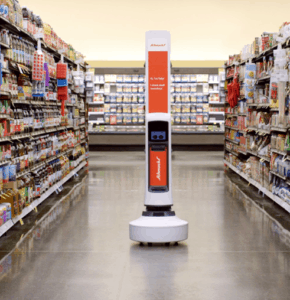Schnuck Markets Inc., a chain of grocery and pharmacy stores founded in 1939, began using robots to keep track of inventory on store shelves more than two years ago. Now, it’s using the same robots—and the data they collect—to help shoppers find products in Schnucks stores.
By the end of October, customers can use the Schnucks Rewards mobile app to find individual items in stores. The app shows consumers aisle, side of the aisle and aisle section information, which they can match to location markers throughout the store. The location data integrates with the app’s electronic shopping list feature, automatically adding the location of each item a consumer adds to her shopping list.
The new app features use information Schnuck Markets already collects via shelf-scanning robots from Simbe Robotics Inc., says Dave Steck, vice president of information technology infrastructure and application development at Schnuck Markets. He spoke about the change on Monday at the Groceryshop conference in Las Vegas.
Last October, Schnuck Markets rolled out the robots to 15 stores, following a successful three-store pilot that began in July 2017. Simbe’s tall, thin robots, called Tally, travel through stores three times per day, scanning about 35,000 products. Thus, the robots help free up staff members for tasks such as assisting customers.

Simbe’s tall, thin robots travel through Schnucks stores three times per day, scanning about 35,000 products.
Schnuck Markets, which operates 115 stores in Missouri, Illinois, Indiana, Wisconsin and Iowa, has been testing the item-location capability at three stores. By the end of October, it plans to roll it out for shoppers at the 15 stores that already use Simbe robots.
Not only do the robots audit the store shelves—a mundane and tedious task for humans—they transmit exact location information to employees tasked with restocking inventory. Those kinds of efficiencies have, by themselves, provided a good return on the retailer’s investment, Steck says. By sharing the data with consumers, the retailer can now pass along the benefits to them.
The idea of integrating the product location data with the shopping app emerged over time, Steck says. As Schnuck Markets and Simbe started digging deeper into the data collected by the robots, the chain and the robotics company realized they could use the information in new ways, Steck says. “There is a lot more capability there, from the data,” he says.
How fast it expands the new app capability to other stores depends on how quickly Schnuck Markets can deploy the robots, Steck says, without being specific. He says it’s not clear the retailer will deploy the technology at all 115 stores. The emphasis will be on stores where customers use the Schnucks Rewards app most heavily, Steck says.
Brad Bogolea, Simbe’s CEO and co-founder, says robots can provide retailers with a wealth of data they can use to serve customers better.
“From a macro perspective, I think this type of technology has the opportunity to help change the customer experience,” Bogolea says.
Simbe, founded in 2014, works with about a dozen retailers around the world, Bogolea says. On Sept. 12, Simbe raised $26 million from investors in a Series A funding round led by Venrock, a venture capital firm, according to Crunchbase data.
